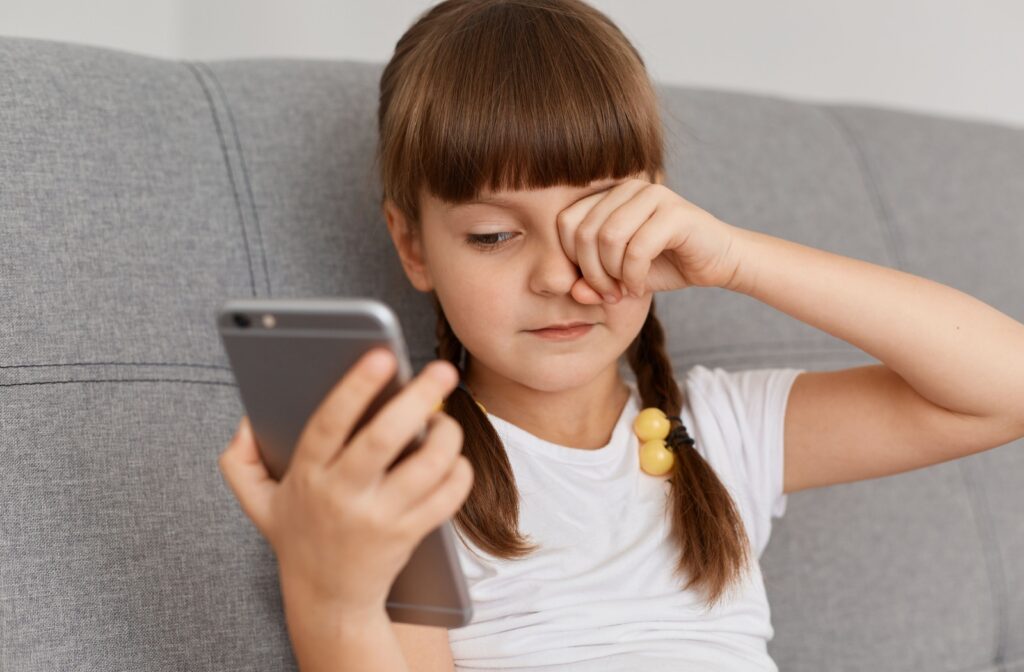Screen time has become a regular habit for many of us, especially as devices dominate both work and leisure. But do endless hours in front of screens harm our vision? Can using our phones, tablets, and computers lead to more serious conditions?
Excessive screen time can indeed impact vision, but there are steps you can take to minimize negative effects. Whether you’re experiencing symptoms of digital eye strain or concerned about your children’s eye health, understanding how screens affect eye health can help you see, work, and play more comfortably.
How Screen Time Impacts Vision
Many people today rely on screens to work, complete errands, or as a source of entertainment. Unfortunately, too much time in front of screens can lead to unpleasant symptoms.
Computer Vision Syndrome
The people at highest risk of computer vision syndrome (CVS) or digital eye strain are those who use screens for two or more continuous hours a day. Symptoms of digital eye strain include:
- Headaches
- Dry eyes
- Blurry vision
- Sore neck and shoulders
Using screens can put a lot of stress on our eyes. Causes of digital eye strain include:
- Untreated eye conditions like astigmatism and hyperopia (farsightedness)
- Poor posture
- Sitting too close or too far from the screen
- Screen glare and lighting problems
Viewing screens can make our eyes work harder than reading from paper. Characters on screens aren’t as sharp as printed text, and glare or poor posture while using devices can exacerbate discomfort. Concentrating for extended periods without blinking or taking breaks can worsen symptoms.
Myopia in Children
Recently, research has linked screen use with myopia in children. Otherwise known as nearsightedness, myopia happens when the eyeball grows too long, which can cause a refractive error and blurry vision.
While there are genetic causes of myopia, its development can be linked to environmental and lifestyle factors. Holding small devices close to our faces and focusing at such a short distance may contribute to myopia.
When children spend more time on screens, this tends to mean they don’t play outside as much. Less outdoor time is also associated with an increased risk of myopia in children.
How to Protect Your Eyes
While screens are unavoidable in today’s world, there are things you can do to lower risks and reduce symptoms. Try integrating the following simple strategies:
The 20-20-20 Rule
One of the easiest ways to reduce eye strain is to include regular breaks during screen time. The 20-20-20 rule means that every 20 minutes, take a 20-second break to look at something 20 feet away. This habit allows your eye muscles to relax, preventing fatigue.
Pro tip: Set timers or download apps that give you friendly reminders to step away!
Consider Eyeglasses
Proper eyewear can minimize strain and help avoid uncomfortable posture changes, like leaning closer to screens. Both regular users of eyeglasses and those who don’t usually wear them can benefit from eyewear designed for computer use, such as glasses fitted with special tints and coatings.
Control Glare & Optimize Clarity
Blue light and glare can contribute to digital eye strain. Move computers away from direct light or windows, and use anti-glare screens to filter excessive light. You can also clean screens more frequently to improve clarity.

Eye Health Tips for Parents
While asking kids to stop playing video games can be difficult, there are things you can do to educate them and encourage a healthier lifestyle.
Teach Kids the Elbow Rule
The elbow rule is an easy-to-remember guideline for healthier vision. Encourage your kids to keep their eyes at least an elbow-to-wrist distance from whatever they’re focusing on.
Encourage Outdoor Play
Outdoor play comes with a variety of benefits that go beyond vision. Playing outside encourages physical activity, reduces obesity and myopia risk, is linked to better mental health, and promotes stronger learning skills like creativity and critical thinking.
Limit Screen Time
The American Academy of Pediatrics offers the following guidelines for screen time among kids:
- Other than video chatting, screen time for children under 18 months old should be very minimal
- For children ages 2 to 5, limit screen time to one hour a day or less
- For grade school children ages 5 and up, monitor how much screen time your kids get. Make sure it’s not taking time away from healthy activities like sleep, exercise, and spending time with loved ones.
Visit the Eye Doctor
Finally, take your children to the optometrist for regular check-ups. This can help catch and treat vision problems early. Generally, children should get their eyes checked for the first time at 6 months old, but a family history of eye problems may warrant an earlier exam.
Eye Care at Fort Myers Eye Associates
At Fort Myers Eye Associates, we believe in proactive, comprehensive eye care. Whether you’re experiencing dry eyes or are concerned about your child’s myopia, we strive to serve each patient with patience and attention and to understand their unique needs.
Book an appointment with us today to learn how we can support you and your loved ones.





